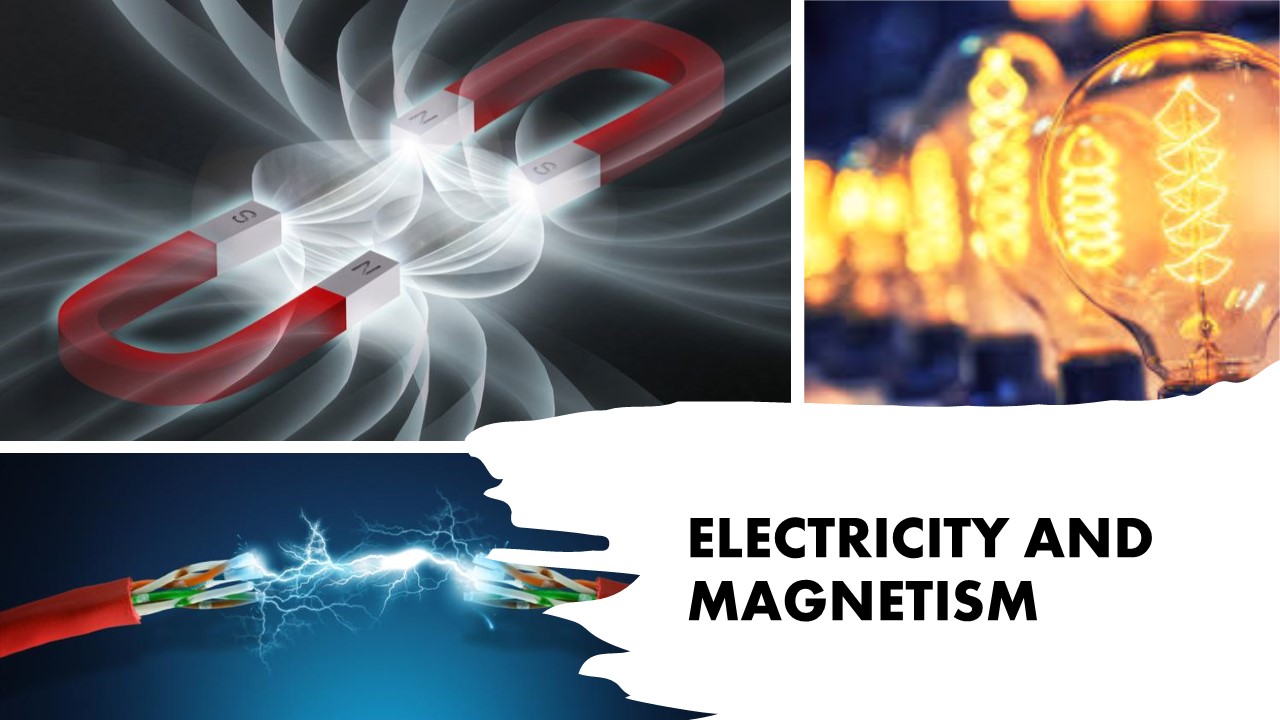STD IX – ELECTRICITY AND MAGNETISM – ARCHIMEDES
About Course
In this section will learn the following chapters:
1.ELECTRICITY
2.MAGNETISM
3.ELECTROMAGNETS
Last Updated:February 16, 2024
0 (0 Ratings)
Share Course
Page Link
Share on social media

Description
ELECTRICITY
ELECTRIC CURRENT:
Some common terminology used in this lesson.
Current: It is defined as the rate of flow of charge.
Conductors: Substances that allow current to flow through them. Example, metals such as copper, aluminium, silver, iron, etc.
Insulators: Substances which do not allow the current to flow through them. Example, cotton, rubber, plastic, wood, paper, etc.
Circuit: The path along which the current flows is called a circuit.
Potential Difference: The potential difference (p.d.) between two points is equal to the work done in moving a unit positive charge from one point to the other.
Resistance: The obstruction offered to the flow of current by the conductor (or wire) is called its resistance.
MAGNETISM
Induced Magnetism and Neutral Points
Magnetism affects magnetic materials and electric currents. The effect of a permanent magnet on ferromagnetic materials is so strong, that a ferromagnetic material can be magnetised to become a permanent magnet. For example, iron, nickel, cobalt etc.
Terms associated with magnets and magnetism:
Magnetic Poles
Induced Magnetism
Magnetic Field of Earth
Neutral Points
ELECTROMAGNET
Electromagnet and its Uses
Humans all over the world have known about magnets for more than 3000 years in the form of naturally occurring magnets called lodestones. Lodestones are magnetised material of the magnetite ore that can attract iron.
The word magnet comes from the Greek phrase, ‘magnitis lithos’, which means a stone from the land of Magnesia.
Even the properties of a magnet have been discussed by the Greeks, Chinese and Indians from around 600 BC, it was from the 11th century onwards its use began, mostly in a compass to find direction.
A magnet is able to attract or repel another magnet or a magnetic material. This magnetic effect of one magnet on another magnet or on a magnetic material is magnetism.
Free
Free
Free access this course
-
LevelIntermediate
-
Total Enrolled3
-
Last UpdatedFebruary 16, 2024
Hi, Welcome back!
Material Includes
- 💻 Online recap of Lessons
- 📒 Worksheet questions and solution
- 📚 Testing and solution
- TEACHING AIDS:
- 🌺 Learning the names and use of all the components of an electrical circuit by making the bulb glow
- 🌺Learn the difference between a primary and a secondary cell
- 🌺Make chart for all formulae related to current, potential difference and Ohm's Law
Course Duration:
0
Course level:Intermediate
Enrolled:3
About Course
In this section will learn the following chapters:
1.ELECTRICITY
2.MAGNETISM
3.ELECTROMAGNETS
Course Curriculum
ELCECTRICITY AND MAGNETISM – CURRENT ELECTRICITY
-
[PHYSICAL] [JESISHA] CURRENT ELECTRICITY – INTRODUCTION
06:55 -
[PPT] [JESISHA] ELECTRICITY – SUPPORT MATERIAL – STATIC ELECTRICITY
01:14 -
[PHYSICAL] [JESISHA] CURRENT ELECTRICITY – INSULATOR AND CONDUCTOR
01:23 -
[PHYSICAL] [JESISHA] CURRENT ELECTRICITY – ELECTRIC CURRENT
11:28 -
[PHYSICAL] [JESISHA] CURRENT ELECTRICITY – TYPES OF CHARGES
06:00 -
[PHYSICAL] [JESISHA] CURRENT ELECTRICITY – SYMBOLS CIRCUIT IN DIAGRAM
05:45 -
[PHYSICAL] [JESISHA] CURRENT ELECTRICITY – SIMPLE ELECTRIC CUIRCUIT
02:12 -
[PHYSICAL] [JESISHA] CURRENT ELECTRICITY – RHEOSTAT
02:12 -
[PHYSICAL] [JESISHA] CURRENT ELECTRICITY – KEYS
03:06 -
[PHYSICAL] [JESISHA] CURRENT ELECTRICITY – GALVONOMETER
01:31 -
[PHYSICAL] [JESISHA] CURRENT ELECTRICITY – CLOSED AND OPEN CIRCUIT
01:33 -
[PHYSICAL] [JESISHA] CURRENT ELECTRICITY – POSITIVE CHARGE AND NEGATIVE CHARGE
10:46
CURRENT ELECTRICITY – POTENTIAL DIFFERENCE AND RESISTANCE WITH NUMERICALS
-
[PHYSICAL] [JESISHA] CURRENT ELECTRICITY – CONCEPT OF RESISTANCE
04:09 -
[PHYSICAL] [JESISHA] ELECTRICITY – POTENTIAL AT A POINT
02:40 -
[PHYSICAL] [JESISHA] ELECTRICITY – EQUATION OF POTENTIAL AT A POINT AND POTENTIAL DIFFERENCE
01:47 -
[PPT] [JESISHA] ELECTRICITY – – ELECTRIC CURRENT AND POTENTIAL DIFFERENCE
05:39 -
[PHYSICAL] [JESISHA] ELECTRICITY – OHM’S LAW
05:34
MAGNETISM – INDUCED MAGNETISM AND NEUTRAL POINTS
-
[PHYSICAL] [JESISHA] MAGNETISM – OCCURANCE MAGNET MAGNESIA
05:27 -
[PHYSICAL] [JESISHA] MAGNETISM – INDUCED MAGNETISM BAR MAGNETS
04:53 -
[PHYSICAL] [JESISHA] MAGNETISM – INDUCED MAGNETISM MAGNETIC FIELD OF EARTH
23:23 -
[PHYSICAL] [JESISHA] MAGNETISM – INDUCTION PRECEDES ATTRACTION
00:46 -
[PHYSICAL] [JESISHA] MAGNETISM – LINES OF MAGNETIC FIELD
08:38 -
[PHYSICAL] [JESISHA] MAGNETISM – SETTING OF A FREELY SUSPENDED MAGNET
05:48 -
[PHYSICAL] [JESISHA] MAGNETISM – MAGNETIC EFFECT OF ELECTRIC CURRENT
02:06
MAGNETISM – ELECTROMAGNET AND ITS USES
-
[PHYSICAL] [JESISHA] MAGNETISM – SHOE ELECTOR – MAGNET
11:24 -
[PHYSICAL] [JESISHA] MAGNETISM – ELECTRIC BELL AND ITS WIRING
03:10 -
[PHYSICAL] [JESISHA] MAGNETISM – I – SHAPED ELECTROMAGNET
08:18
ADDITIONAL MATERIAL
-
[PHYSICAL] [JESISHA] ELECTRICITY – CORE CONCEPT – INTRODUCTION
07:13 -
[PHYSICAL] [JESISHA] ELECTRICITY – CORE CONCEPT A – INTRODUCTION
05:20 -
[PHYSICAL] [JESISHA] ELECTRICITY – CORE CONCEPT – SOURCES – PRIMARY AND SECONDARY CELLS
02:12 -
[PHYSICAL] [JESISHA] ELECTRICITY – CORE CONCEPT – CONDUCTORS AND INSULATORS
01:55 -
[PHYSICAL] [JESISHA] ELECTRICITY – CORE CONCEPT – SIMPLE ELECTRICAL CIRCUIT
01:07 -
[PHYSICAL] [JESISHA] ELECTRICITY – CORE CONCEPT – CONCEPT OF CURRENT AND UNITS
02:15 -
[PHYSICAL] [JESISHA] ELECTRICITY – CORE CONCEPT – FLOW OF ELECTRONS AND CONVENTIONAL CURRENT
08:20 -
[PHYSICAL] [JESISHA] ELECTRICITY – CORE CONCEPT – SYMBOLS USED IN SIMPLE ELECTRICAL CIRCUITS
04:21 -
[PHYSICAL] [JESISHA] ELECTRICITY – CORE CONCEPT – COMPONENTS OF ELECTRICAL CIRCUIT
09:06 -
[PHYSICAL] [JESISHA] ELECTRICITY – CORE CONCEPT – OPEN AND CLOSED CIRCUITS
02:21 -
[PPT] [RHEA] MAGNETISM – SUPPORT MATERIAL – NATURAL AND ARTIFICIAL MAGNETS
02:21 -
[PPT] [RHEA] MAGNETISM – SUPPORT MATERIAL – EARTH’S MAGNETIC FIELD
02:22 -
[PPT] [RHEA] MAGNETISM – SUPPORT MATERIAL – MAGNETIC FIELD
01:09 -
[PPT] [JESISHA] ELECTRICITY AND MAGNETISM – SUPPORT MATERIAL – ELECTRIC CIRCUIT AND CHARGE
01:38 -
[PPT] [RHEA] MAGNETISM – SUPPORT MATERIAL – FLEMING’S LEFT HAND RULE
01:08 -
[PPT] [RHEA] MAGNETISM – SUPPORT MATERIAL – NATURAL AND ARTIFICIAL MAGNETS
02:21 -
[PPT] [RHEA] MAGNETISM – SUPPORT MATERIAL -ELECTROMAGNETIC INDUCTION
01:44
ASSIGNMENT AND DUE DATES
Student Ratings & Reviews

No Review Yet

